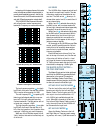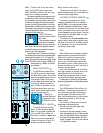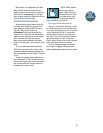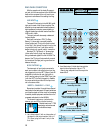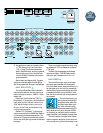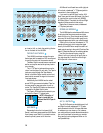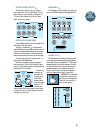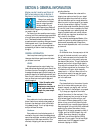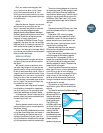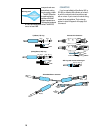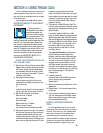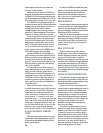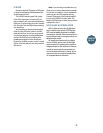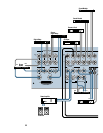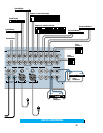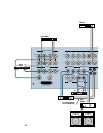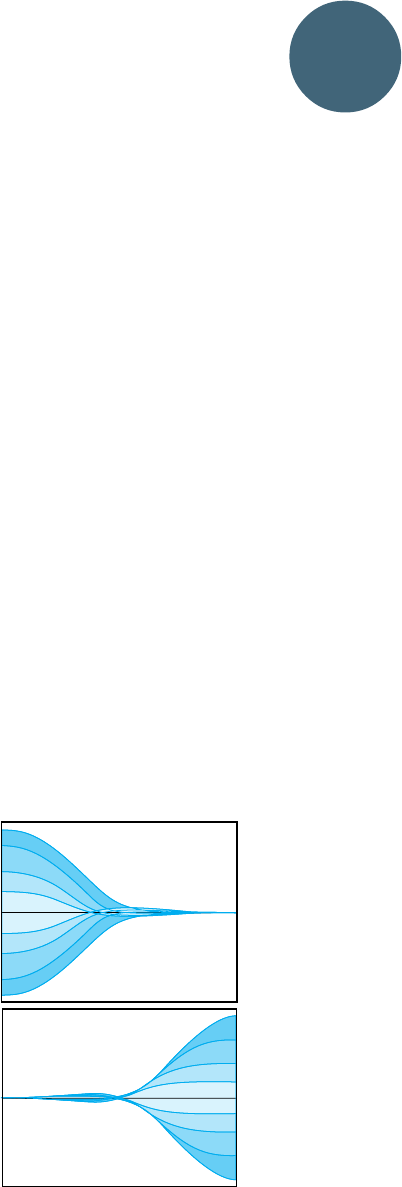
17
But if your music is sounding good, don’t
worry if you’re in the yellow a lot or if some
parts of the track hardly read at all. You’ll
quickly get a feel for what works for you, when
you can get away with really smacking the tape
or the electronics.
BUSES
More often than not, the goal in a mixing con-
sole is to mix two or more inputs into one
output. Like a coach who has two or more play-
ers to get to the same ballgame, console
designers use a bus. Even Webster’s Unabridged
Dictionary agrees, defining the word bus in elec-
tronics as “a conductor serving as a common
connector for three or more circuits.”
The Mackie LM-3204 has 12 buses. The four
suggested in the name (the main Left and Right
buses and the Alt 3–4 buses) are important, but
there are also Auxiliary buses (two stereo and
two mono = six) and a pair of solo buses. We will
try to be clear just what bus we are talking about
when we do talk about buses.
SENDS AND RETURNS
Sends are buses fed to outputs, and returns
are inputs. So why don’t we call them outputs
and inputs?
Well, actually, the terms send and return
can mean many things, but the way they are
generally used in mixing console parlance is
to refer to send buses, which tap off a little of
a signal to send to some effects device (like a
reverberation unit), and return inputs, which
function to return that reverb back into the
mix. The original, unprocessed signal is called
the “dry” signal. The reverb unit’s output sig-
nal is called the “wet” signal.
Sends are also used to tap some of the signal
from a collection of channels for a headphone
cue mix or monitor mix. For that matter, sends
can be used as additional mix buses, if needed.
In the same way, if you don’t need returns for
reverb or effects, they can be used as additional
line level inputs to your mix.
SOLO
Solo is a standard console function that al-
lows you to listen to one or more sources all by
themselves (soloed).
You can check EQ, possible distortion or buzz,
or just listen to see if a particular mic is open or
not. When soloing more than one source, you
can listen to the blend of just part of your mix:
only a flute sample on channel one, for example,
or just the percussion module on channel eight.
The solo circuits are designed not to interrupt
the recording process. The solo bus signal is sent
directly to the Control Room and Headphone
outputs without affecting any of the other inputs,
outputs or recording buses. Solo circuits on the
LM-3204 are “After Fader Listen” (AFL), mean-
ing the soloed channel’s gain control affects the
solo level.
EQ
Everybody knows what EQ is, but just in case
you’d like a refresher, we’ll put in a few para-
graphs here.
Equalization (EQ) refers to purposely
changing the frequency response of a circuit,
sometimes to correct for previous unequal re-
sponse (hence the term, equalization), and
more often to add or subtract level at certain
frequencies for a pleasing effect.
Bass and treble controls on your stereo are
EQ; so are the units called parametrics and
graphics and notch filters.
A lot of how we refer to equalization has to do
with what a graph of the frequency response
would look like. A flat response (no EQ) is a
straight line; a peak looks like a hill, a dip is a val-
ley, a notch is a really skinny valley, and a shelf
looks like a plateau (or a shelf). The slope is the
grade of the hill on the graph.
Graphic equalizers have enough frequency
slider controls to form a visual representation
of the EQ curve right on the front panel.
Parametric EQs let you vary several EQ para-
meters at once. A filter is simply a form of
equalizer which allows certain frequencies
through unmolested and other frequencies
are attenuated or removed.
The equalizer on the LM-3204 combines
two different types of EQ into three different
sections.
The LO and HI sections of the EQ are shelving
equalizers. As you can
see, shelving EQs lift or
lower the entire range
of frequencies above or
below a certain point.
The LO EQ on the
LM-3204 is at 80 Hz and
the HI is at 12 kHz, and
can vary the bass and
treble by 15dB. We
picked these frequen-
cies because they make
for a more musical and
pleasant sounding
equalizer; they give you
GENERAL
INFO
Hi shelf
Lo shelf



